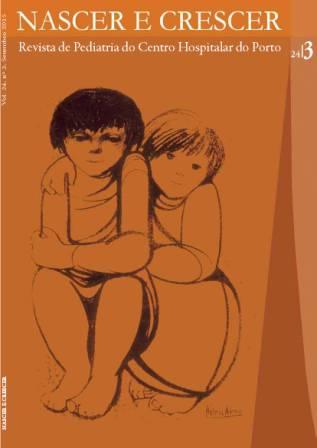Recurrent intestinal occlusion / sub-occlusion in the neonatal period: intestinal dysplasia or imaturity?
DOI:
https://doi.org/10.25753/BirthGrowthMJ.v24.i3.8542Keywords:
intestinal neuronal dysplasia, intestinal obstruction, prematurityAbstract
Introduction: Changes in intestinal motility may be due to primary or secondary causes, the most serious clinical manifestation is intestinal pseudo-obstruction. However, in the neonatal period this may be due to abnormalities of intestinal innervation and / or varying degrees of immaturity of ganglion cells.
Clinical Case: A preterm infant 26 weeks of gestation presented, at the 43rd day of life a clinical picture suggestive of necrotizing enterocolitis type IIA, which was not confirmed. In the following months she presented with successive subocclusive and occlusive intestinal episodes, ending in ileostomy. The anatomopathological examination revealed some myenteric and submucosal plexus (with increase in the number of ganglion cells) and some larger nodes than usual. The subsequent clinical course was favorable with good weight gain requiring, however, transient artificial nutritional support; reconstitution of intestinal transit occurred after 21 months.
Discussion/Conclusions: The authors present this case of intestinal neuronal dysplasia emphasizing the favorable prognosis associated with intestinal growth and maturity with age.
Downloads
References
Schäppi MG, Staiano A, Milla PJ, Smith VV, Dias JA, Heuschkel R, et al. A Practical Guide for the Diagnosis of Primary Enteric Nervous System Disorders. Journal of Pediatric Gastroenterology and Nutrition 2013; 57:677-86.
Martucciello G, Prato AP, Puri P, Holschneider AM, Meier-Ruge W, Jasonni V, et al. Controversises concerning diagnostic guidelines for anomalies of the enteric nervous system: A report from the fourth International Symposium on Hirschsprung’s disease and related neurocristopathies. Journal of Pediatric Surgery 2005; 40:1527-31.
Ferry GD, MD. Constipation in children: Etiology and diagnosis; Uptodate: May 2012. http://www.uptodate.com/contents/ constipation-in-children etiology-and-diagnosis?source=search_result&search= constipation+in+children&selectedTitle=2%7E150.
Martucciello G, Torre M, Prato AP, Lerone M, Campus R, Leggio S, et al. Associated anomalies in intestinal neuronal dysplasia. Journal of Pediatric Surgery 2002; 37:219-23.
Kobayashi H, Hirakawa H, Puri P. Is Intestinal Neuronal Dysplasia a Disorder of the Neuromuscular Junction?. Journal of Pediatric Surgery 1996; 3:575-9.
Puri P. Pediatric Surgery. In: Grosfeld JL, Junior JA O’Neill, Fonkalsrud EW, Coran AG. Intestinal Neuronal Dysplasia. 6th ed. United States: Mosby Elsevier Inc. 2006;1560-5.
Ure BM, Holschneider AM, Schulten D, et al. Clinical Impact of Intestinal Neuronal Malformations: A Prospective Study in 141 Patients. Pediatric Surgery Int 1997; 12:377-82.
Kobayashi H, Yamataka A, Fujimoto T, Lane GJ, Miyano T. Mast Cells and Gut Nerve Development: Implications for Hirschsprung’s Disease and Intestinal Neuronal Dysplasia. Journal of Pediatric Surgery 1999; 34:543-8.
Gillick J, Tazawa H, Puri P. Intestinal Neuronal Dysplasia: Results of Treatment in 33 Patients. Journal of Pediatric Surgery 2001; 36(5):777-9.
Komborozos VA, Skrekas GJ. Neuronal intestinal dysplasia: an entity of chronic intestinal pseudo-obstruction. Annual of Gastroenterology 2000; 13:95-7.
Meier-Ruge W A, Ammann KBE, et al. Updated results on intestinal neuronal dysplasia (IND B). Eur Journal of Pediatric Surgery 2004;14:384-91.
Montedonico S, Acevedo S, Fadda B. Clinical Aspects of Intestinal Neuronal Dysplasia. Journal of Pediatric Surgery 2002; 37:1772-4.
Oğuzkurt P, Senocak ME, Akçören Z, Büyükpamukçu N. Diagnostic Difficulties in Neuronal Intestinal Dysplasia and Segmental Colitis. Journal of Pediatric Surgery 2000; 35:519-21.
Burki T, Kiho L, Scheimberg I, Phelps S, Miisra D, Ward H, et al. Neonatal funcional intestinal obstrution and the presence of severely imature gagnglion cells on rectal biopsy: 6year experience. Pediatr Surg Int 2011; 27:487-90.
Yanai T, Kobayashi H, Yamataka A, Lane GJ, Miyano T, Hayakawa T, et al. Acetylcholine-Related Bowel Dysmotility in Homozygous Mutant NCX/HOX1 1L.1- Deficient (NCX-/-) Mice – Evidence That Acethylcholine is Implicated in Causing Intestinal Neuronal Dysplasia. Journal of Pediatric Surgery 2004; 39:927-30.
Downloads
Published
How to Cite
Issue
Section
License
Copyright and Authors' Rights
All articles published in Nascer e Crescer - Birth and Growth Medical Journal are Open Access and comply with the requirements of funding agencies or academic institutions. For use by third parties, Nascer e Crescer - Birth and Growth Medical Journal adheres to the terms of the Creative Commons License "Attribution - Non-Commercial Use (CC-BY-NC)".
It is the author's responsibility to obtain permission to reproduce figures, tables, etc. from other publications.
Authors must submit a Conflict of Interest statement and an Authorship Form with the submission of the article. An e-mail will be sent to the corresponding author confirming receipt of the manuscript.
Authors are permitted to make their articles available in repositories at their home institutions, provided that they always indicate where the articles were published and adhere to the terms of the Creative Commons license.


